
by Larry Williams | Aug 14, 2020
Oleander caterpillars, which are active on some oleanders during summer, can provide a number of gardening lessons.
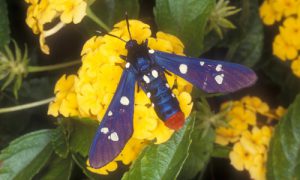
Oleander caterpillar moth on lantana flower. Photo credit: James Castner, UF
The adult moth is striking in appearance. The bluish to purplish moth has white dots on its black wings. The moths resemble wasps as they fly in and around oleander shrubs.
It’s the orange caterpillars with black spots and black hairs that cause problems for some gardeners.
Caterpillars are the larval stage of butterflies and moths. In order to enjoy watching butterflies and moths feeding on the nectar of flowers, some of the caterpillars must survive to become adult butterflies and moths. This is lesson number one.
Oleander caterpillars usually only feed on oleander plants. Oleanders are native to areas of Europe and Asia. This is lesson number two.
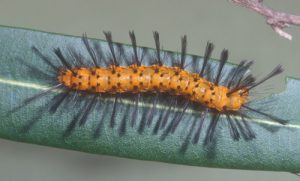
Oleander caterpillar, Photo credit: Paul Choate, UF
Oleander caterpillars benefit by us planting their food source in Florida.
This relationship between pest and plant is referred to as the key plant, key pest concept. Some other examples include St. Augustinegrass and chinch bugs, gardenias and whiteflies, crape myrtles and crape myrtle aphids, azaleas and azalea caterpillars, camellias and tea scale, roses and black spot, pecans and pecan scab, squash and squash vine borers.
Understanding this concept can be helpful in designing a “low maintenance” landscape.
When you plant roses, you plant everything that goes with roses, including the time and money required to maintain them. This applies to St. Augustinegrass, pecan trees, squash and oleanders. This is lesson number three.
Oleander caterpillars can temporarily damage the appearance of oleanders. But they cause no long-term damage for the plant. This is lesson number four. The damage is aesthetic. Oleander caterpillars can consume great numbers of leaves. However, if the plant is otherwise healthy, new leaves will be produced and the plant will continue to grow. The damage is temporary; there will be no evidence the plant ever had a problem.
To spray or not to spray for oleander caterpillars has to do with a person’s tolerance level.
If you can’t tolerate having oleander caterpillars around and the temporary aesthetic damage they cause, consider the use of Bacillus thuringiensis. It is sold under a number of brand names and many times is referred to as Bt. This bacterium only controls caterpillars so it is friendlier for the beneficial insects. When using any pesticide, always follow the label directions and precautions.
Here are links to UF/IFAS Extension publications with more info.
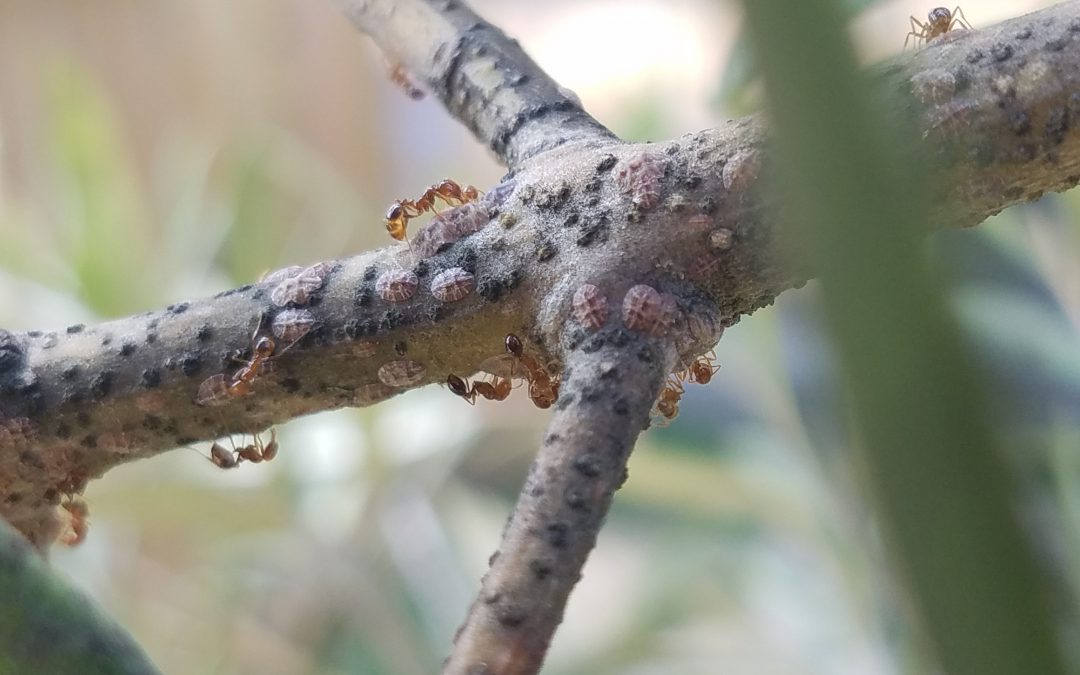
by Evan Anderson | Aug 6, 2020
Nature is full of examples of animals that use camouflage to protect themselves, and some of the best examples are found in the insect world. They may appear to be leaves, sticks, thorns, or flowers; there are insects that disguise themselves as snakes, bird poop, or other more dangerous insects. While many of these adaptations protect them from predators such as birds or spiders, they may also make it difficult to identify a bug that’s causing a problem in the garden!
There are several insect pests of plants that may not appear to be what they are at first glance. This can make frustrating to figure out what’s harming a plant, and identification is a very important first step in solving any problem. Here are some of the more common critters that wear disguises in our area, though.

The ants in this picture are attracted by the scale insects, which look like oval bumps on the stem of the plant.
Scale Insects vary in shape, but many of them appear to be simply another bump on the stem or leaf of a plant. They often form a waxy covering over their bodies and stay put, simply feeding in place on the juices within the plant. Ants may notice them, however, and are attracted to the sticky, sugary substance that they exude called honeydew. This honeydew drips onto other stems and leaves, and may grow sooty mold, a black or gray coating that might make one think the problem is fungus. Look for scale insects if you notice these signs (and be aware that other insects such as aphids or mealybugs also produce honeydew).
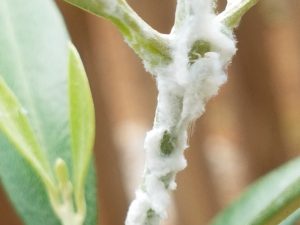
Some psyllids or immature planthoppers cover themselves in white fuzz as protection.
Psyllids, mealybugs, and aphids are all different insects, but some species of each use a waxy coating to protect themselves. This gives them a white, fuzzy appearance that may appear at first glance to be a fungal growth. A close look can reveal the truth – that the fuzz is hiding a plant pest within.
Planthoppers and sharpshooters can be pests of certain plants, including grapes. They may appear to be bumps or thorns on a stem, but usually move or jump if approached.
Caterpillars may disguise themselves in a number of ways. Some may blend in with the foliage that surrounds them, while others appear to be twigs or even the aforementioned bird poop (in the case of the giant swallowtail butterfly, whose larvae enjoy feeding on citrus leaves). It is typically the damage to the plant that is first noticeable. Unlike the other insects mentioned here which feed by piercing into a plant and sucking out the juices, caterpillars have chewing mouthparts. Leaves with holes in them are a good sign that you might have a caterpillar problem.
Remember that not every insect is a pest, and not all pests do enough damage to warrant controlling them. If you need help determining if an insect you’ve seen in your garden or landscape is a problem, contact your local Extension office. You can also find more information on all of these insects and more in our EDIS publications, a few of which are listed below:
Scale insects: https://edis.ifas.ufl.edu/pdffiles/MG/MG00500.pdf
Mealybugs: https://edis.ifas.ufl.edu/in1149
Caterpillars: https://edis.ifas.ufl.edu/topic_landscape_caterpillar_pests
by Evan Anderson, Walton County Horticulture Agent
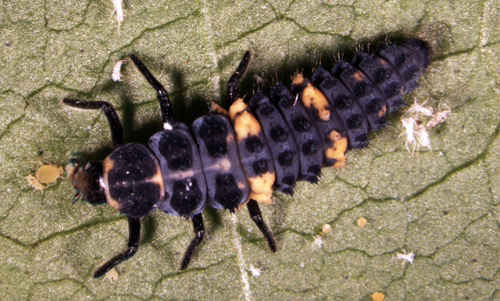
by Daniel J. Leonard | Aug 6, 2020
I know this is going to come as a shock to some readers, but not all bugs are bad. In fact, while there are over 1 million species of insects worldwide, less than 1% are problem pests! This problem 1%, composed of common garden pests, including aphids, stinkbugs, nuisance caterpillars, and scales, get all the attention and for good reason; they can be extremely destructive to home and commercial crops. However, the good guys, beneficial predatory insects, are out there too, providing valuable pest control day and night and should be considered in part of a quality garden pest management strategy.
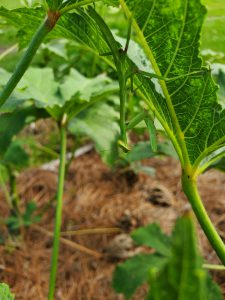 Beneficials come in many shapes and sizes. Some are commonly known predators, such as spiders, Lady Beetles and Praying Mantids, while others are lesser known pest nemeses, like Paper Wasps, Pirate Bugs, and Lacewings. Regardless, gardeners should do their homework and be able to identify beneficials when they see them and allow them to do their jobs. The presence, or not, of a handful of Lady Beetles or Lacewings on the attack can be the difference between needing to treat with insecticides for an aphid outbreak or just letting nature take its course. Studies have shown that just one individual Lady Beetle in the larval stage can consume as many as 500 aphids; adult Lady Beetles are even hungrier aphid eaters! Paper Wasps, you know the ones who make the large “papery” nests around eaves of house and other structures, play an important beneficial role, frequently preying on caterpillars. If their nests aren’t near highly trafficked areas around your home and you don’t have family members allergic to wasp stings, your garden will thank you for leaving a few paper wasp colonies as caterpillar insurance!
Beneficials come in many shapes and sizes. Some are commonly known predators, such as spiders, Lady Beetles and Praying Mantids, while others are lesser known pest nemeses, like Paper Wasps, Pirate Bugs, and Lacewings. Regardless, gardeners should do their homework and be able to identify beneficials when they see them and allow them to do their jobs. The presence, or not, of a handful of Lady Beetles or Lacewings on the attack can be the difference between needing to treat with insecticides for an aphid outbreak or just letting nature take its course. Studies have shown that just one individual Lady Beetle in the larval stage can consume as many as 500 aphids; adult Lady Beetles are even hungrier aphid eaters! Paper Wasps, you know the ones who make the large “papery” nests around eaves of house and other structures, play an important beneficial role, frequently preying on caterpillars. If their nests aren’t near highly trafficked areas around your home and you don’t have family members allergic to wasp stings, your garden will thank you for leaving a few paper wasp colonies as caterpillar insurance!
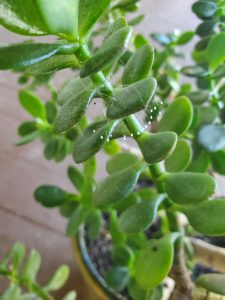
Lacewing eggs on a Jade plant in close proximity to the author’s vegetable garden.
In many instances, beneficial insects can keep pest insect infestations at bay, allowing gardeners to spot treat outbreaks when they get out of hand or even prevent the problem from needing chemical intervention altogether.
As helpful as they are, beneficial insects in the garden won’t totally negate the need for chemical treatment entirely. From time to time, garden pest populations outpace the beneficials’ abilities to kill them and intervention from humans is needed. In these times, it is advisable to use a couple of best practices to limit exposure to beneficial insects. First, try to use selective insecticides that only target specific pests and are nontoxic to other bugs, like the product Bt for caterpillar pests (sold under many brands like Dipel, Garden Safe Bt Worm and Caterpillar Killer, Thuricide, etc). However, if a nonselective, general insecticide, like the Pyrethroids (many common homeowner insecticide brands) and carbamates (Sevin and others), is needed, timing these broad spectrum sprays for early in the morning and late in the evening when many beneficials are not very active can help reduce friendly fire casualties. Care should also be taken to only spot treat infested plants and not the entire garden, this helps reduce beneficial exposure to these broadly toxic pesticides.
Every gardener should have a plan for pest control and beneficials can play an important role in this overall strategy. Gardeners can help ensure that nature pulls its weight in controlling problem pests by taking a little time to scout for beneficial insect populations, keeping a close eye on developing pest outbreaks, using selective insecticides when you can, and only spraying broad spectrum products as spot treatments when necessary and timing those applications for very early or late in the day. If you have a question about whether or not a garden insect is a good guy or a pest or want more information on garden pest control strategies, contact your local UF/IFAS County Extension Office! Happy Gardening!
The following resources were used in the development of this article:
https://gardeningsolutions.ifas.ufl.edu/care/florida-friendly-landscapes/beneficial-insects.html
https://sfyl.ifas.ufl.edu/sarasota/gardening-and-landscaping/horticulture-commercial/integrated-pest-management/beneficial-insects/
http://www.missouribotanicalgarden.org/gardens-gardening/your-garden/help-for-the-home-gardener/advice-tips-resources/pests-and-problems/other/beneficial-insects.aspx
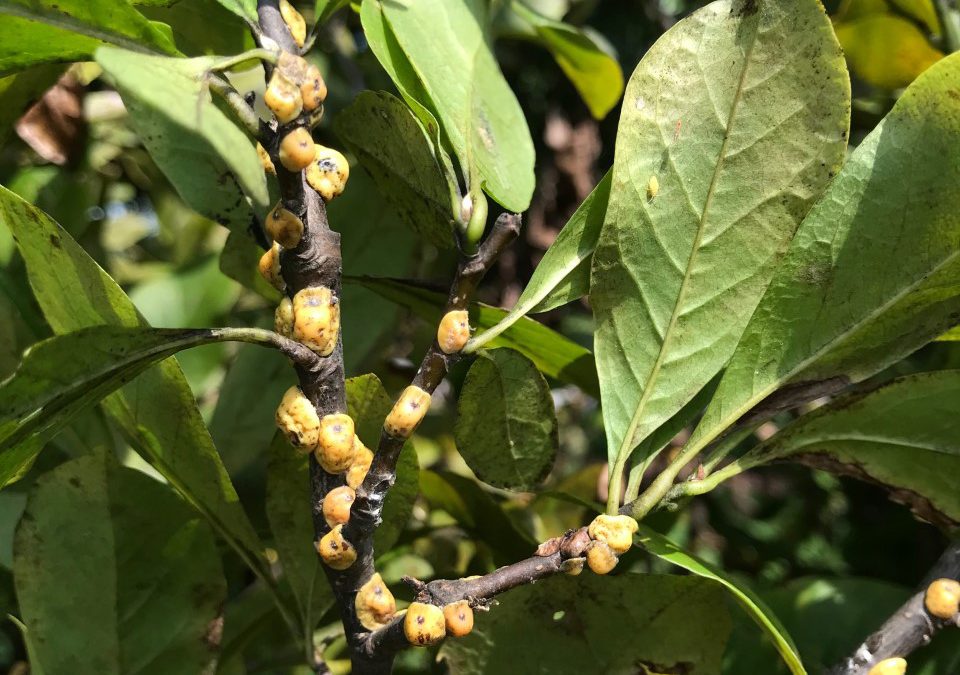
by Sheila Dunning | Jul 30, 2020
Do you notice a large number of bees or wasps visiting your magnolia tree? Do you see “bumps on the twigs”? Are the leaves and branches turning black? It is probably Magnolia or Tuliptree scale.
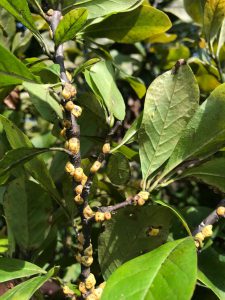
Photo by: Rebecca Bolestra
These scale belongs to a group of insects referred to as soft scales. Scale insects feed by inserting their piercing-sucking mouthpart into the plant’s vascular system and removing sugar and water from the tissue. As the insects feed the fluids become concentrated in the gut of the scale, forcing them to excrete a clear, sticky liquid called honeydew. The honeydew drips onto the leaves, stems and anything else below. Honeydew serves as a growth media for sooty mold, the thin layer of black fungus that forms on the surface. The honeydew is a food source for other insects, like bees and wasps. But, the sooty mold prevents sunlight from reaching the leaf surface, preventing photosynthesis from occurring.
Scales are identified by their body covering. Magnolia scale (Neolecanium cornuparum) is one of the largest soft scale, measuring up to ½ inch in diameter. They range from pink-orange to dark brown in color and are often covered with a white wax at maturity. Tuliptree scale (Toumeyella liriodendri) is a similar appearing scale that can infest magnolia species. But, it does not form the white wax.
Magnolia and Tuliptree scale reaches maturity in August with one generation per year. The female lays her eggs, which hatch internally and form crawlers that move from under the body covering and migrate to the underside of small twigs, where they will spend the winter. Once settled in, the young scales begin to feed and never move again, growing larger in the same spot.
Now is the time to take action. For small trees, the scales can be removed by hand with a soft brush. Horticultural oil will smother adults and crawlers, if the trees to be treated are larger or time is limited. Systemic insecticides can be applied for lasting effects. Imidacloprid is a pesticide that can be applied as a soil-drench, reducing the potential for harm to pollinating insects. In the fall, insecticidal soap can be applied to control the crawlers that hatched. Plan on treating the tree again next year. Scale population suppression usually requires at least two years of pest management. For more information on scale insect management go to: https://edis.ifas.ufl.edu/pdffiles/MG/MG00500.pdf

by Matt Lollar | Jul 30, 2020
On a daily basis, it is not unusual for our Extension Office to get calls, emails, and walk-ins with questions about insect identification. Sometimes we even get questions about imaginary insects! The overwhelming opinion by our clientele is that the insects in question are harmful to their landscapes and gardens. This is not always the case since there are more than 100,000 species of insects found in the United States, but less than 1% are harmful.
Recently I received a call about an abundance of bugs in a client’s newly installed sod. He was concerned that the insects were taking over his yard. Luckily, he was able to submit some good quality photos so the University of Florida/IFAS Extension Service could help him identify the insects.

An adult ground beetle (Mochtherus tetraspilotus). Photo Credit: Michael C. Thomas, Florida Department of Agriculture & Consumer Services
The photos were sent to a University of Florida Entomologist for identification verification. It turns out the insects were ground beetles (family Carabidae). Adult ground beetles are slender and range between 1/4″ and 3/8″ in length. Their head and thorax are much narrower than their abdomens. Ground beetles are beneficial insects that feed on moth eggs and larvae. They are known predators of soybean loopers, cabbage loopers, and velvetbean caterpillars. It is suspected that the beetles found by the client came from the sod farm and were living in the thatch layer of the sod. They were possibly feeding on sod webworms or other moth larvae.
Accurate identification is the first step of integrated pest management (IPM). In this case, the insect found wasn’t a pest at all. If you need help identifying an insect, feel free to contact your local Extension Agent. For more information on beneficial insects, visit these publications found at edis.ifas.ufl.edu.

by Julie McConnell | Jul 16, 2020
We hope you were able to join us for Gardening in the Panhandle LIVE! Butterfly Gardening on July 9th to learn about attracting butterflies to your Florida gardens. As promised, we have compiled a list of butterfly resources that we talked about during the webinar and a few extra that we didn’t have time to cover.
If you were not able to join us live, you can still watch the videos on Facebook or YouTube
Click on the topic of interest for links to resources:
Don’t forget to tune in for our next Gardening in the Panhandle LIVE! on July 23rd for Prepping for the Fall Garden. Register for that webinar on Zoom or Follow our Facebook Event for updates.
For a full list of upcoming webinars visit Gardening in the Panhandle: LIVE!















